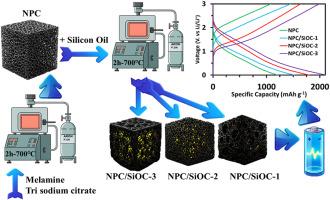基于氮掺杂多孔碳和二氧化硅纳米颗粒的锂离子电池高性能杂化阳极
IF 7.9
2区 工程技术
Q1 CHEMISTRY, PHYSICAL
引用次数: 0
摘要
在本研究中,利用工业前驱体,通过一步热解法合成了氮掺杂多孔碳纳米片。为了提高锂的存储性能,通过热处理将氧化碳化硅(SiOC)纳米颗粒均匀地结合到NPC基体中,减轻了体积膨胀和结构降解。得到的NPC/SiOC复合材料具有高孔隙率、改善的结构完整性和增强的电化学行为。通过扫描电子显微镜(SEM)、能量色散x射线能谱(EDX)、x射线衍射(XRD)、傅里叶变换红外光谱(FTIR)、布鲁诺尔-埃米特-泰勒(BET)分析和电化学技术进行表征,证实了SiOC纳米颗粒具有均匀的杂化结构和大量的活性位点。在复合材料中,NPC/SiOC-2(具有最佳SiOC负载)具有1780 mAh g - 1的最高可逆容量,出色的倍率能力,在200次充放电循环后容量保持率超过90%。电化学阻抗谱(EIS)显示,导电NPC框架和拟电容SiOC相之间的协同作用降低了电荷转移电阻,改善了离子扩散。这些发现证明了NPC/SiOC混合材料作为锂离子电池耐用、高容量负极材料的前景。该战略为开发先进的储能系统提供了一种低成本、可扩展、环保的途径,突出了NPC/SiOC复合材料在下一代电池技术中的潜力。本文章由计算机程序翻译,如有差异,请以英文原文为准。

High-performance hybrid anodes based on nitrogen-doped porous carbon and SiOC nanoparticles for lithium-ion batteries
In this study, nitrogen-doped porous carbon (NPC) nanosheets are synthesized via a one-step pyrolysis method using industrial precursors. To enhance lithium storage performance, silicon oxycarbide (SiOC) nanoparticles are uniformly incorporated into the NPC matrix through thermal treatment, mitigating volume expansion and structural degradation. The resulting NPC/SiOC composites exhibit high porosity, improved structural integrity, and enhanced electrochemical behavior. Characterization by scanning electron microscopy (SEM), energy-dispersive X-ray spectroscopy (EDX), X-ray diffraction (XRD), Fourier-transform infrared spectroscopy (FTIR), Brunauer–Emmett–Teller (BET) analysis, and electrochemical techniques confirms a homogeneous hybrid structure with well-dispersed SiOC nanoparticles and numerous active sites. Among the composites, NPC/SiOC-2 (with optimal SiOC loading) delivers the highest reversible capacity of 1780 mAh g−1, excellent rate capability, and over 90 % capacity retention after 200 charge/discharge cycles. Electrochemical impedance spectroscopy (EIS) reveals reduced charge transfer resistance and improved ion diffusion, attributed to the synergistic interaction between the conductive NPC framework and the pseudo-capacitive SiOC phase. These findings demonstrate the promise of the NPC/SiOC hybrid as a durable, high-capacity anode material for lithium-ion batteries. The strategy offers a low-cost, scalable, and environmentally benign route for developing advanced energy storage systems, highlighting the potential of NPC/SiOC composites in next-generation battery technologies.
求助全文
通过发布文献求助,成功后即可免费获取论文全文。
去求助
来源期刊

Journal of Power Sources
工程技术-电化学
CiteScore
16.40
自引率
6.50%
发文量
1249
审稿时长
36 days
期刊介绍:
The Journal of Power Sources is a publication catering to researchers and technologists interested in various aspects of the science, technology, and applications of electrochemical power sources. It covers original research and reviews on primary and secondary batteries, fuel cells, supercapacitors, and photo-electrochemical cells.
Topics considered include the research, development and applications of nanomaterials and novel componentry for these devices. Examples of applications of these electrochemical power sources include:
• Portable electronics
• Electric and Hybrid Electric Vehicles
• Uninterruptible Power Supply (UPS) systems
• Storage of renewable energy
• Satellites and deep space probes
• Boats and ships, drones and aircrafts
• Wearable energy storage systems
 求助内容:
求助内容: 应助结果提醒方式:
应助结果提醒方式:


